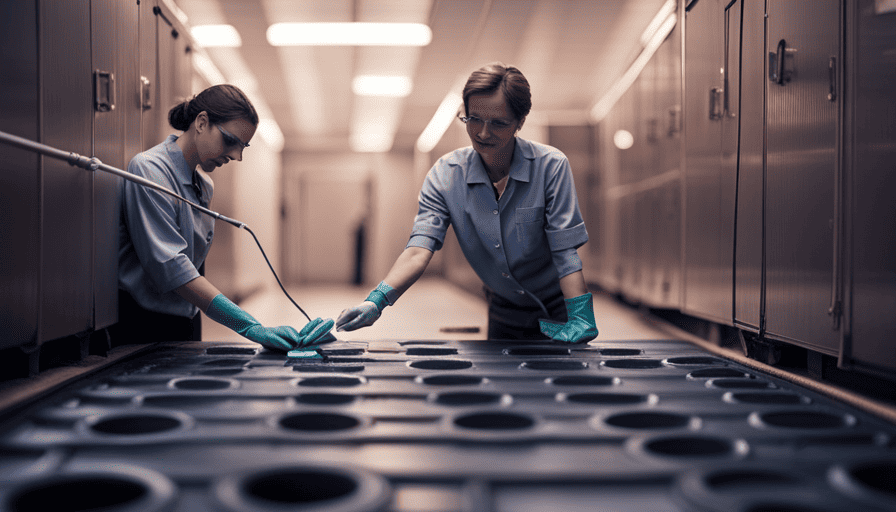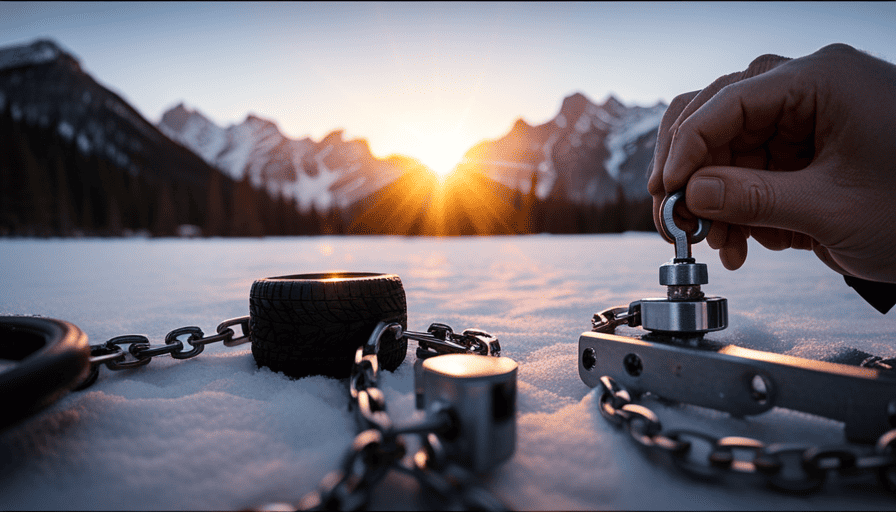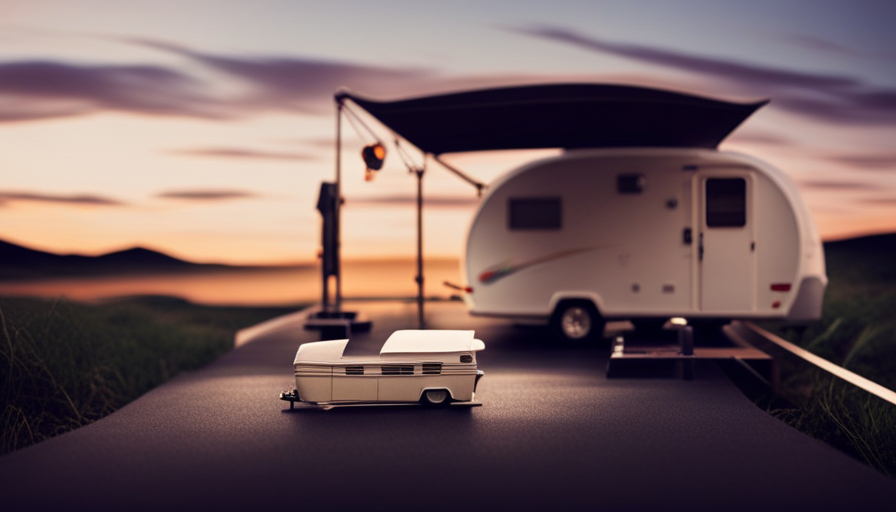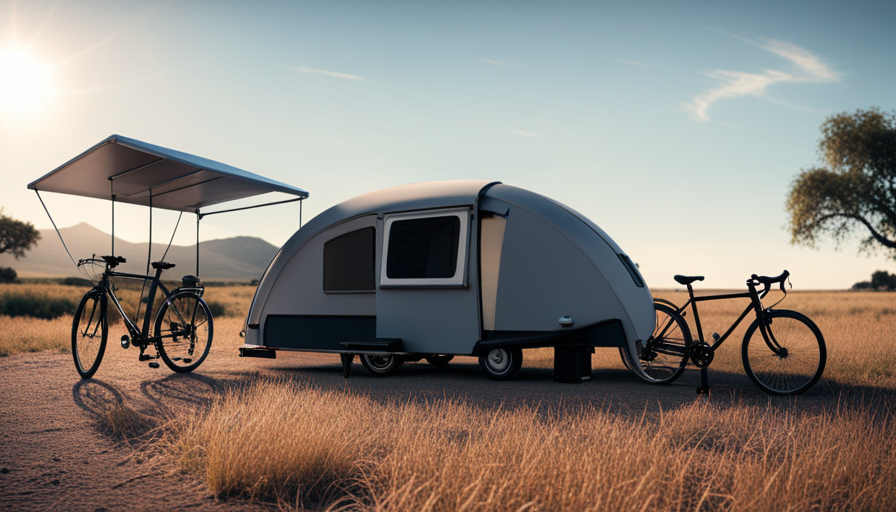Cleaning your RV water tank is akin to providing your vehicle with a revitalizing bath following an extended trip through grime and dust. As someone who is passionate about camping, I grasp the significance of maintaining clean and potable water for use in cooking, drinking, and sanitation. Failing to regularly clean your water tank can result in undesirable smells, the proliferation of bacteria, and potential health hazards.
In this comprehensive guide, I will walk you through the step-by-step process of effectively cleaning your camper water tank. With just a few supplies and a little elbow grease, you’ll be able to maintain a pristine water system for all your camping adventures. From draining and scrubbing the tank to rinsing and testing the water, I’ll cover it all.
So, let’s dive in and ensure that your camper water tank is as clean as can be, providing you with fresh water for a worry-free camping experience.
Key Takeaways
- Cleaning the camper water tank is crucial for maintaining clean and safe water for cooking, drinking, and cleaning.
- Neglecting to clean the water tank can lead to unpleasant odors, bacteria growth, and health risks.
- It is important to drain and refill the tank regularly to prevent stagnant water and maintain cleanliness.
- Using a water filtration system designed for RVs and regularly replacing filters can help remove bacteria and contaminants from the water.
Gather the necessary supplies
Before starting the cleaning process, make sure you’ve gathered all the necessary supplies. Supplies needed include bleach, a bucket, a hose, and a scrub brush. Having these items on hand will make the cleaning process much easier and more efficient.
Now that you have all the supplies ready, let’s go over the steps to follow. First, turn off the water supply to the camper and ensure that the water tank is empty. This is important to avoid any accidents or spills during the cleaning process.
Next, mix a solution of water and bleach. The recommended ratio is 1/4 cup of bleach for every 15 gallons of water in the tank. Use the scrub brush to thoroughly clean the inside of the water tank, making sure to reach all the corners and crevices.
After scrubbing, let the bleach solution sit in the tank for at least 30 minutes to effectively disinfect it. Once the time is up, drain the water tank using the hose, making sure to remove all the bleach solution.
With the water tank now clean and empty, you can move on to the next step: draining the water tank.
Drain the water tank
To start, it’s important to note that approximately 70% of the tank’s capacity can be drained in just a few minutes. Proper drainage is crucial for effective water tank maintenance.
There are several drainage methods you can choose from, depending on the design of your camper water tank. One common method is to open the drain valve located at the bottom of the tank. This allows gravity to do its job and empty the majority of the water. Another option is to use a pump or siphon to remove the water from the tank. This may be necessary if the drain valve is not easily accessible or if there is limited space for water to flow out freely.
Whichever method you choose, make sure to take the necessary precautions to prevent water from spilling and causing a mess.
Once the water tank is drained, you can move on to the next step and prepare a cleaning solution.
Now that the water tank is drained, it’s time to prepare a cleaning solution.
Prepare a cleaning solution
Once you’ve drained the tank, it’s time for you to whip up a solution for a sparkling clean. Cleaning the camper water tank is an important process to maintain the quality of your water.
To prepare a cleaning solution, follow these steps:
- First, gather the necessary materials: a bucket, bleach or vinegar, and water.
- For a bleach solution, mix ¼ cup of bleach with every 15 gallons of water in the tank. Use a funnel to pour the solution into the tank.
- For a vinegar solution, mix 1 cup of vinegar with every 5 gallons of water in the tank. Again, use a funnel to pour the solution into the tank.
- Once the solution is in the tank, fill it up completely with fresh water.
- Let the solution sit in the tank for at least 12 hours. This will allow it to thoroughly clean and disinfect the tank.
- After the designated time, drain the tank again, making sure to flush out all the cleaning solution.
Before starting the cleaning process, remember to take safety precautions. Use gloves and goggles to protect your skin and eyes from any chemicals. Also, ensure proper ventilation in the area where you’re working.
Now that the tank is empty and clean, it’s time to move on to the next step: scrubbing the inside of the tank.
Scrub the inside of the tank
Now that the tank’s sparkling and fresh, it’s time to roll up my sleeves and give the inside of the tank a thorough scrubbing. Cleaning the inside of the camper water tank is crucial to ensure its proper functioning and prevent contamination.
To effectively clean the tank, I’ll use various cleaning techniques to remove any buildup, residue, or bacteria that may be lurking inside. First, I’ll prepare a cleaning solution by mixing warm water with a mild detergent or bleach. This solution will help break down any grime or stubborn stains.
Using a long-handled brush, I’ll scrub the entire interior of the tank, paying extra attention to corners and hard-to-reach areas. This will ensure that all surfaces are thoroughly cleaned and no contaminants are left behind. During the scrubbing process, it’s important to be thorough and meticulous. I’ll scrub the walls, bottom, and even the lid of the tank to eliminate any potential sources of contamination. By using circular motions and applying gentle pressure, I can effectively remove any dirt or residue.
Once the inside of the tank has been scrubbed clean, it’s time to move on to the next step: rinsing the tank thoroughly. This step is crucial to remove any leftover cleaning solution and ensure that the tank is ready for use.
Rinse the tank thoroughly
Make sure you thoroughly rinse the tank to remove any residual cleaning solution, as this step is essential for ensuring the safety of your water supply. Did you know that according to a study, inadequate rinsing of water tanks can lead to bacterial contamination in up to 80% of cases?
After scrubbing the inside of the tank, it’s crucial to rinse it thoroughly to eliminate any remaining dirt, debris, or cleaning agents. Thorough cleaning and effective rinsing are key to maintaining a clean and safe water tank for your camper.
To achieve a thorough rinse, start by filling the tank with clean water. Allow the water to circulate throughout the tank, ensuring it reaches every corner and surface. Then, drain the water completely, making sure there’s no residue left behind. Repeat this process at least two to three times to ensure all contaminants are removed.
By thoroughly rinsing the tank, you eliminate any potential health hazards that may arise from leftover cleaning agents or contaminants. Once the tank’s rinsed, you can proceed to the next step of sanitizing the tank with a bleach solution. This’ll further ensure the cleanliness and safety of your camper’s water supply.
Sanitize the tank with a bleach solution
Ensure the safety of your water supply by sanitizing your tank with a powerful bleach solution that will eliminate any harmful bacteria lurking inside. Before starting the sanitization process, make sure to rinse the tank thoroughly to remove any debris or sediment. Once the tank is clean, it’s time to sanitize it using a bleach solution.
To create a bleach solution, mix 1/4 cup of bleach for every 15 gallons of water in a container. Carefully pour the solution into the tank, making sure it reaches all areas. Let the solution sit in the tank for at least four hours, allowing it to effectively kill any bacteria. During this time, it is important to keep the tank closed and avoid using any water from it.
While bleach is a commonly used sanitization method, there are alternative options available. Some people prefer using hydrogen peroxide or vinegar as a natural alternative to bleach. However, it is important to note that these alternatives may not be as effective in killing bacteria.
Using a bleach solution does come with some potential risks. Bleach can be corrosive, so it is crucial to use the correct amount and properly dilute it. Additionally, if not rinsed thoroughly, bleach residue can be harmful when ingested. Therefore, it is important to flush the tank with clean water after sanitization to remove any traces of bleach before using the water for drinking or cooking purposes.
In the next section, we will discuss how to flush the tank with clean water to ensure a fresh and safe water supply.
Flush the tank with clean water
To complete the process, you’ll want to give the tank a thorough rinse with fresh water, ensuring that it’s free from any remaining residue or contaminants.
After sanitizing the tank with a bleach solution, flushing it with clean water is an essential step in maintaining a safe and clean water supply for your camper.
Start by filling the tank with fresh water, making sure to open all the faucets and drain any remaining bleach solution. This’ll help remove any traces of bleach and eliminate any lingering odors.
Next, turn on the water pump and let the clean water run through all the faucets, including the hot water taps, for a few minutes. This’ll help flush out any remaining bleach solution from the pipes and ensure that the entire system is clean.
It’s important to remember that regular flushing of the tank with clean water is crucial in preventing bacterial growth and maintaining the quality of your water supply. By removing any potential contaminants and residue, you can ensure that your camper’s water system remains safe and free from harmful bacteria.
In the next section, we’ll discuss how to test the water for cleanliness, ensuring that your camper’s water supply is ready for use.
Test the water for cleanliness
After flushing the tank with clean water, you’ll want to see if the water is safe by testing it for cleanliness. Checking the water quality is an important step to ensure the health and safety of everyone using the camper. Clean water is essential for drinking, cooking, and maintaining hygiene while on the road. To test the water, you can use a water testing kit specifically designed for RV water systems. This kit will help you determine if the water is free from harmful bacteria, contaminants, or any other impurities. It is crucial to regularly check the water quality, especially before embarking on a trip or after the camper has been sitting unused for a while. Remember, the cleanliness of the water directly affects your well-being and overall camping experience.
Moving on to maintaining the cleanliness of the tank, it is important to follow a regular cleaning schedule and take preventive measures to keep the water in the tank clean and safe.
Maintain the cleanliness of the tank
Now, you may be thinking, ‘Who needs a sparkling tank anyway? Let’s just let the bacteria throw a wild party in there!’ But trust me, my friend, neglecting the maintenance of your tank can lead to some seriously unpleasant surprises down the road.
So, let’s talk about ways to prevent bacteria growth and the importance of regular tank cleaning.
To maintain the cleanliness of your camper water tank, there are a few steps you can take. Firstly, make sure to sanitize the tank regularly. This can be done by using a mixture of bleach and water. Simply add a quarter cup of bleach for every 15 gallons of water in your tank, then fill it up and let it sit for at least one hour. After that, drain the tank completely and flush it with clean water.
In addition to sanitizing, it’s crucial to keep your tank clean by regularly flushing it out. This means draining and refilling the tank every few weeks, especially if you’re not using it frequently. By doing so, you’ll prevent stagnant water and reduce the risk of bacterial growth.
By following these maintenance steps, you can ensure that your camper water tank remains clean and bacteria-free. So, take the time to keep it in top condition and enjoy clean and safe water on your camping trips!
Enjoy clean and safe water on your camping trips!
So you think drinking from a stagnant pool of mystery liquid in the middle of nowhere sounds like a great idea, huh? Well, my friend, let’s talk about how to actually enjoy clean and safe water on your camping trips without risking a bacterial invasion.
Maintaining water quality and preventing bacterial growth in your camper’s water tank is essential for a worry-free outdoor adventure. To start, it’s crucial to regularly clean and sanitize your camper’s water tank. Before each trip, make sure to drain any remaining water from the tank and remove any debris or sediment. Then, prepare a mixture of bleach and water and pour it into the tank. Let it sit for a few hours, ensuring that the solution reaches all corners of the tank. Afterward, thoroughly rinse the tank with clean water to remove any traces of bleach.
Additionally, consider investing in a water filtration system specifically designed for RVs. These systems can effectively remove bacteria, viruses, and other contaminants, ensuring that the water you consume is safe and clean. Remember to replace the filters regularly to maintain their effectiveness.
Lastly, practice good water management habits while camping. Avoid filling your tank with untreated water from unknown sources, as it may contain harmful bacteria. Instead, opt for commercially bottled water or use a reliable water purification method.
By maintaining water quality and preventing bacterial growth, you can have peace of mind and enjoy clean and safe water on your camping trips. Don’t compromise your health and well-being, take the necessary steps to ensure your water is always pristine.
Frequently Asked Questions
How often should I clean my camper water tank?
I recommend sanitizing your camper water tank at least once every three months to maintain optimal cleanliness and water quality. Following best practices for cleaning the tank is essential in preventing the growth of harmful bacteria and maintaining the overall hygiene of the system. Regular cleaning ensures that you and your family have access to safe, clean water during your camping adventures.
Can I use a homemade cleaning solution instead of buying one?
Yes, you can use a homemade cleaning solution as an alternative to buying one for cleaning your camper water tank. There are pros and cons to using homemade cleaning solutions.
On the positive side, homemade solutions are often cheaper and can be made with common household ingredients. However, it’s important to note that homemade solutions may not be as effective as commercially available ones. Additionally, using the wrong ingredients or proportions could potentially damage your water tank or leave behind residue.
Is it safe to use dish soap to clean the inside of the tank?
Using dish soap to clean the inside of a camper water tank is not recommended. While dish soap may remove some dirt and grime, it isn’t designed to effectively sanitize the tank or remove bacteria. Instead, I suggest using a cleaning solution specifically formulated for water tanks or a vinegar and water mixture. These alternatives are better at killing bacteria and ensuring a clean, safe water supply.
It’s important to prioritize the best cleaning methods for a camper water tank to maintain optimal hygiene.
What should I do if I notice a foul smell coming from the tank after cleaning?
To remove a foul odor from your camper water tank, there are a few steps you can take. First, flush the tank with a mixture of white vinegar and water, allowing it to sit for a few hours before draining.
Then, rinse the tank thoroughly with clean water. If the odor persists, you may need to repeat this process or consider using a specialized tank cleaner.
To prevent future foul smells, regularly clean and sanitize your tank, and ensure it’s properly sealed to prevent contamination.
Are there any specific maintenance steps I should follow to keep the tank clean between trips?
To keep the camper water tank clean between trips, it’s crucial to follow specific maintenance steps. Regularly sanitize the tank using a bleach solution or specialized tank cleaner. Flush the tank with clean water before each trip to remove any contaminants.
Additionally, consider installing a water filter system to prevent bacterial growth. These maintenance practices will help ensure a clean and safe water supply for your camper adventures.
Can Cleaning the Water Tank Help Prevent the Need to Change Water Pipes in a Camper?
Cleaning the water tank regularly is crucial in preventing the need for changing water pipes in a camper. By removing sediments and bacteria that accumulate over time, the tank remains clean, reducing the risk of corrosion and pipe blockages. Proper maintenance ensures the water flows smoothly, prolonging the lifespan of the pipes in a camper.
Conclusion
In conclusion, cleaning your camper water tank is an essential task to ensure clean and safe water during your camping adventures. By following the steps outlined in this article, you can easily maintain the cleanliness of your tank.
Remember to gather the necessary supplies, drain and scrub the tank, and rinse it thoroughly. Once you’ve tested the water for cleanliness, you can enjoy peace of mind knowing that your water is free from any contaminants.
So, don’t delay, grab your cleaning supplies and get ready to embark on a journey of clean and refreshing water in your camper!










